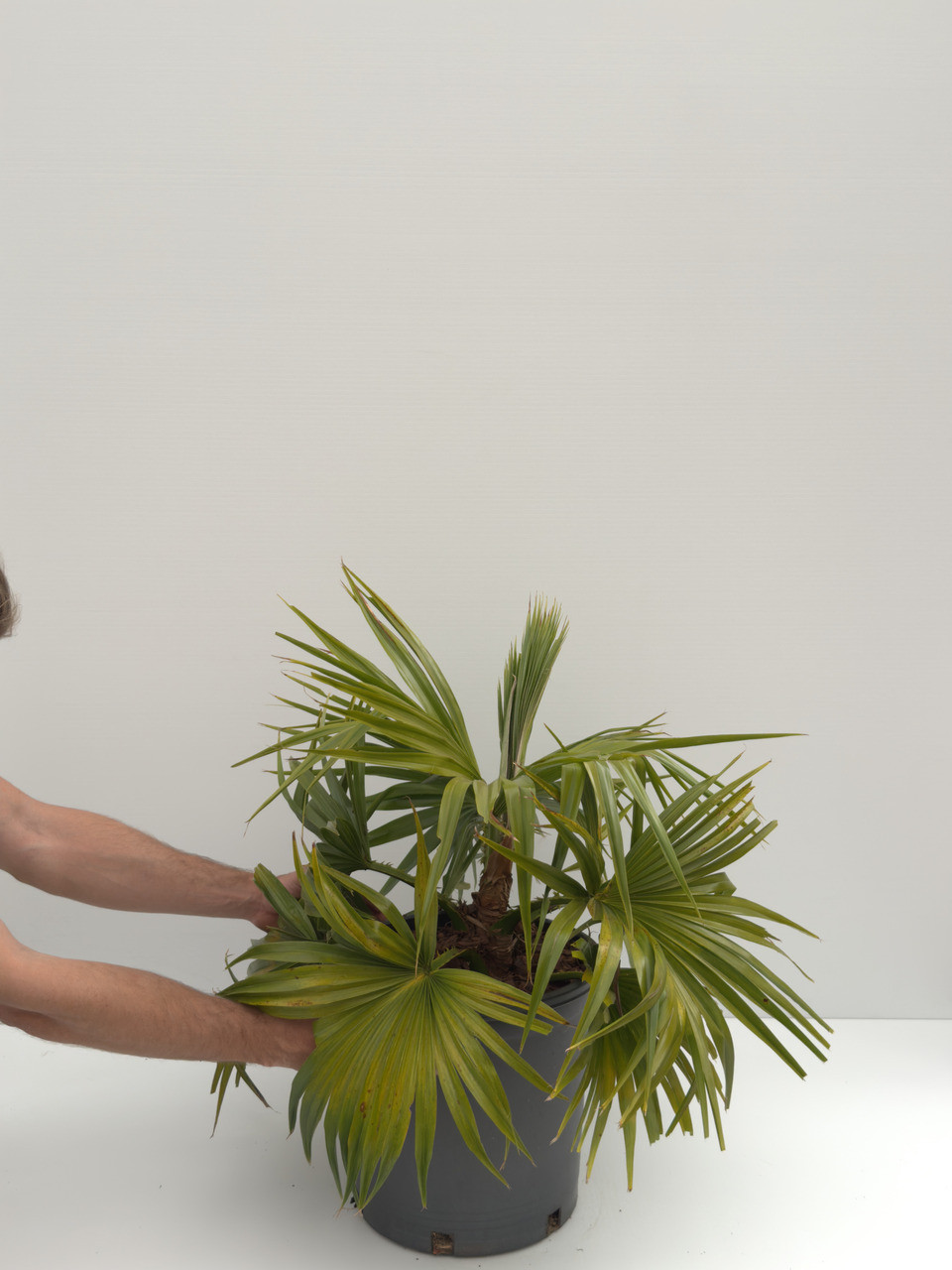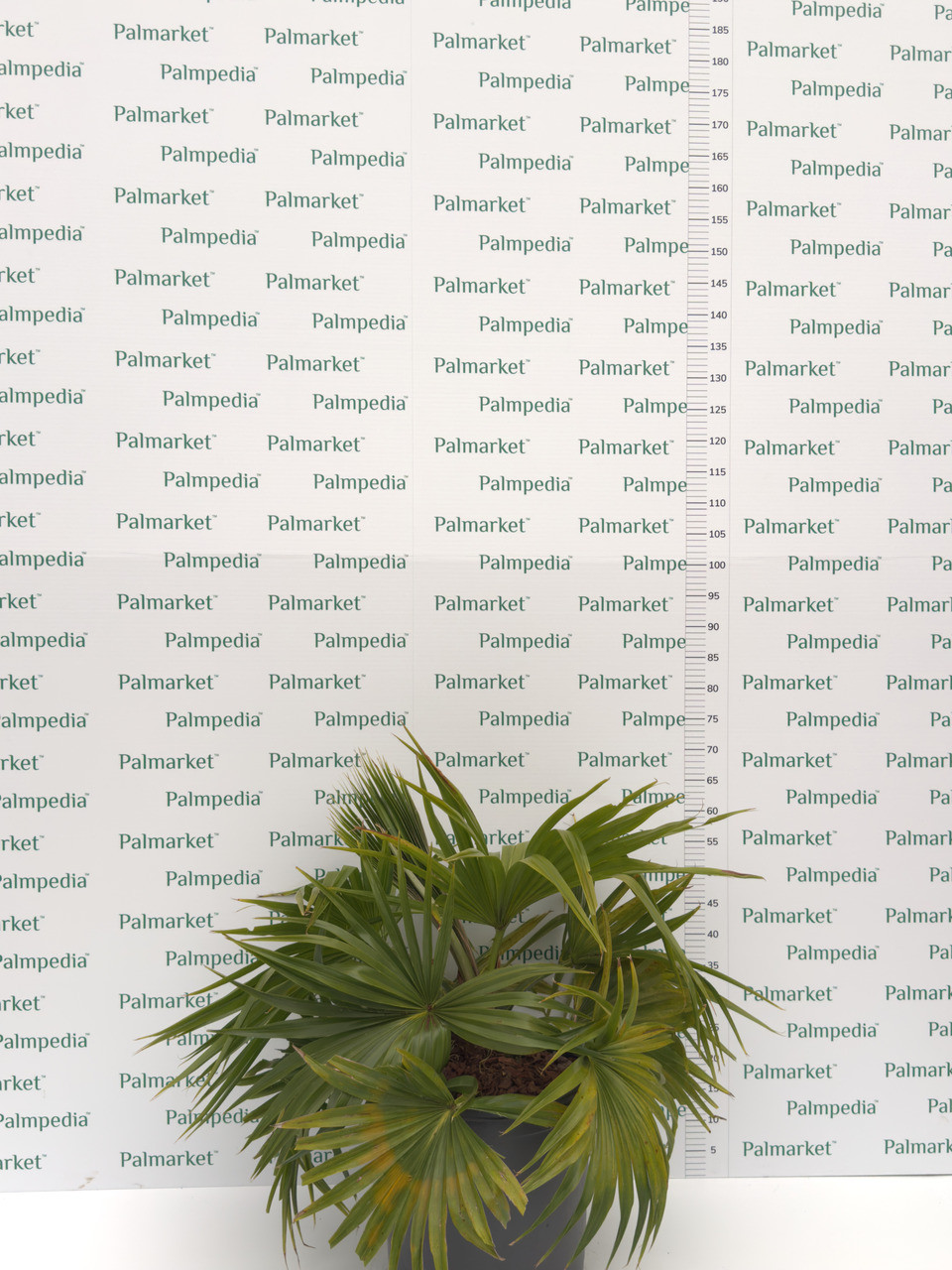Product Description
Habitat and Distribution
Bermuda, China Southeast, Florida, Hawaii, Japan, Jawa, Kazan-retto, Marianas, Mauritius, Nansei-shoto, New Caledonia, Ogasawara-shoto, Réunion, Taiwan, and Vietnam. Japan, China and Taiwan. In Japan, on the Ryukyu Islands of Okinawa, riomote and Aharen, and on Kyushu, Aoshima (Yoshida et al., 2000) and Shikoku (Horikawa, 1972; Suzuki, 1982). In Taiwan on Kisanto Is., and in China on Hainan Is. and formerly recorded in Guangdong Province but now apparently extinct there in the wild. Coastal forests on various soils, often in sand, sometimes in dense mono-specific colonies, otherwise in small isolated colonies, 1-100 m alt. (Dowe, J.L.)/Palmweb.
Description
Hermaphroditic, Solitay palm. Trunk to 15 m tall, 20-30 cm in diam. breast high, leaf scars obscure, roughened and with remnant tissue, light coloured, internodes narrow, irregular, brown to grey with age, petiole stubs not persistent, longitudinal fissures prominent. Leaves 40-60 in a globose to ovoid crown; petiole slightly arching, to 180 cm long, about 15 cm wide in the middle, adaxially flat or slightly ridged, surface glabrous; margins with single curved spines in the proximal one-half or less or sometimes absent, distal margins otherwise sharp and slightly winged; spines 2-20 mm long, subulate, green to black; leaf-base fibre not prominent, coarse, and disintegrating; lamina costapalmate, regularly segmented, subcircular to reniform, 120-200 cm long, 120-180 cm wide, light yellowish green on both surfaces, dull to glossy, nonwaxy; lamina divided for 45-55% of its length, with 50-90 segments, depth of apical cleft about 13% of the segment length, apical lobes pendulous; lower segments 2-5 mm wide, filamentous, parallel veins 8-9 each side of midrib; transverse veins thinner than parallel veins; hastula about 3 cm high. Inflorescence unbranched at the base, 100-120 cm long, not extending beyond the limit of the crown, slightly curving, branched to 3 orders; 6-7 partial inflorescences; rachillae 10-18 cm long, to 9 mm in diameter, glabrous; peduncular bract(s) lacking; rachis bracts tomentose or scaly, loosely tubular, disintegrating into open chartaceous fibres with age, brown, apex acute. Flowers in clusters of 4-7, subglobose in bud, 2-2.5 mm long, white to yellowish; sepals imbricate, about 1.5 mm long, rounded, margins hyaline, inner surface striate; petals triangular, apically pointed, fleshy, about 2.2 mm long, about 2 mm wide; filaments united at the base, free in the upper part, connective thickish, about 0.5 mm long; anthers about 0.5 mm long; style sharply tapered, about the same height as the anthers. Fruit globose, subglobose, ellipsoid or pyriform,15-26 mm long, 9-18 mm wide, glossy blue-green to bright green; epicarp ceramic-like; suture line extends for full length of fruit, marked with lip-like structures; mesocarp about 1.5 mm wide, fleshy, slightly oily, moderately fibrous, endocarp woody, about 0.5 mm wide; pedicel 2-3 mm long. Seed globose, subglobose to ellipsoid, variously reniform in longitudinal section, about 14 mm long, about 10 mm wide; endosperm intruded by the testa to about one-half to two-thirds through to form a cavity filled with brown crystalline tissue; embryo supra-lateral to lateral. Eophyll 7-ribbed. (Dowe, J.L.)/Palmweb. Editing by edric.
Culture
Chinese fan palm is not particular about soil. Fertilize twice a year in spring and summer with a good quality slow release fertilizer that contains micro-nutrients. Light: Likes direct sun and bright situations. Young plants look better when grown in part shade. Moisture: This palm forms a long tap root and can survive extended periods of drought. Provide adequate moisture for more rapid growth. This palm may be hardier than Zone 8 where I have grown several for more than 20 years. Sheltered under live oak trees, these specimens routinely survive temperatures in the mid twenties with no ill effect. They have survived temperatures as low as 15 degrees which burnt the leaves but they recovered and all are still flourishing! They also seem resistant to the fungus diseases that attacked other "semi-hardy" palms after sustaining cold damage. Propagation:By seed. If kept warm they will germinate in about 2 months time. USDA Hardiness, zone: 9B (Floridata.
Comments and Curiosities
Phenology: Flowers Feb-Apr; fruits Apr-Sept.
Etymology: Livistona chinensis; the genus is named for the baron of Livingston and the species name chinensis is Latin for 'of China'.
There are two subspecies; Livistona chinensis var. chinensis, China Southeast, and Vietnam. And Livistona chinensis var. subglobosa, Bermuda, Florida, Hawaii, Japan, Jawa, Marianas, Mauritius, Nansei-shoto, New Caledonia, La Réunion, and Taiwan. Conservation: Vulnerable.
Our ancestors did not have the prosperous material life as we do now, but they knew how to utilise various natural resources as different tools, and Chinese Fan Palm is a good example. Its leaves are composed of tough fibres, so people bound the leaves on the tip of a wooden stick to make a durable broom. Also, as its name suggested, some used its leaves to make fans, or hats, to cope with the hot summer. (conservancy.org.uk)
A much-loved fan palm that has been popular since Victorian times and makes a superb potted palm for the home or terrace. In warmer climates and over a period of years, it grows into a handsome, medium-sized tree with a slender trunk. The common name is something of a misnomer since it is actually native to Japan's Ryukyu Islands and Volcano Islands. The broad, lime green leaves have elegantly drooping and curled tips, which gives rise to its other name, "Fountain palm." The fruits, which are produced in large numbers, are blue. Livistona chinensis shows a good tolerance to cold and frost and may be used in the sheltered temperate garden, but will also happily accept hot and humid tropical conditions. (RPS.com)














